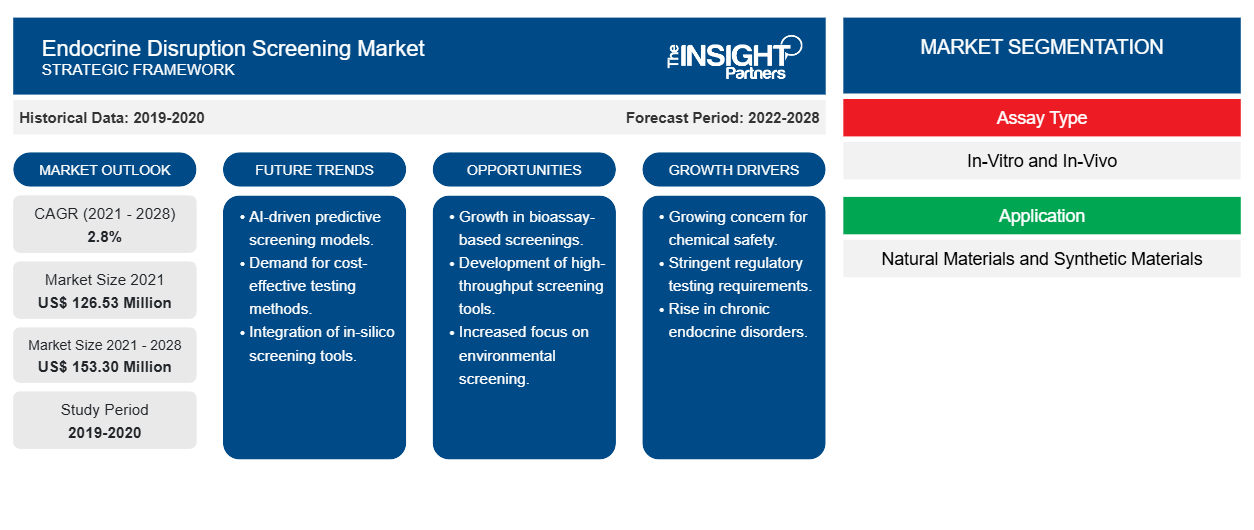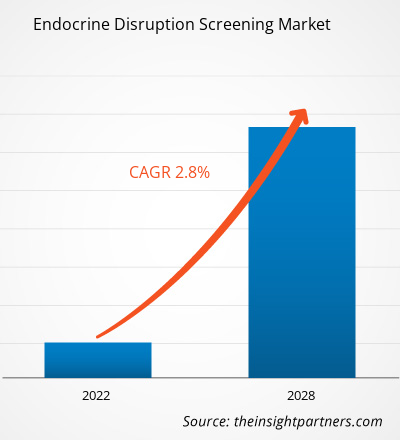内分泌かく乱スクリーニング市場は、2021年の1億2,653万米ドルから2028年には1億5,330万米ドルに達すると予測されており、2021年から2028年にかけて2.8%のCAGRで成長すると予想されています。
天然および人工の化学物質の多くは、体内のホルモンを調節する内分泌系を模倣したり、阻害したりする可能性があります。内分泌かく乱物質として知られるこれらの化学物質は、発達障害、生殖障害、脳障害、免疫障害、およびその他の障害に関連しています。内分泌かく乱物質は、一部のプラスチックボトルや容器、金属製の食品缶のライナー、洗剤、難燃剤、食品、玩具、化粧品、農薬など、さまざまな一般的な物品に含まれている可能性があります。農薬、化学物質、環境毒素は、内分泌かく乱物質スクリーニングによって、エストロゲン、アンドロゲン、甲状腺ホルモン系への潜在的な影響について 2 段階方式でスクリーニングされます。
内分泌かく乱スクリーニング市場の成長は、バイオテクノロジー分野の研究の増加と内分泌障害の罹患率の上昇によるものです。しかし、スクリーニング技術の高コストが市場の成長を妨げています。
要件に合わせてレポートをカスタマイズする
このレポートの一部、国レベルの分析、Excelデータパックなど、あらゆるレポートを無料でカスタマイズできます。また、スタートアップや大学向けのお得なオファーや割引もご利用いただけます。
- このレポートの主要な市場動向を入手してください。この無料サンプルには、市場動向から見積もりや予測に至るまでのデータ分析が含まれます。
市場洞察
内分泌疾患の増加が内分泌かく乱スクリーニング市場を牽引
先端巨大症(成長ホルモンの過剰産生)、肥満、メタボリックシンドローム、空腹時血糖異常、耐糖能異常、骨粗鬆症、骨減少症、軽度から中等度のビタミンD欠乏症、勃起不全、脂質異常症、甲状腺炎は、米国の成人の少なくとも5%に及ぶ有病率を示す内分泌疾患です。これらの疾患のうち、勃起不全の発生率が最も高いのは男性で、骨減少症/骨粗鬆症の発生率が最も高いのは女性です。小児糖尿病と下垂体腺腫は最も一般的でない疾患で、米国の人口の1%未満が罹患しています。副腎皮質癌、褐色細胞腫、下垂体腺腫は、最も発生率が低い疾患です。副甲状腺機能亢進症と甲状腺疾患は、女性に多く見られます。糖尿病は少数民族の間で最も多くみられます。内分泌疾患と代謝疾患は、特に米国やその他の国々で高リスクの個人に対して十分な栄養とスクリーニング プログラムを実施している現代の人間の最も一般的な病気の 1 つです。副甲状腺機能亢進症、原発性および続発性性腺機能低下症、成長ホルモン欠乏症、甲状腺機能低下症などの内分泌疾患は、代謝性骨疾患や糖尿病などの他の疾患につながる可能性があります。したがって、このような疾患の有病率と発症率の増加により、内分泌かく乱スクリーニング製品の需要が高まっています。
アッセイタイプに基づく洞察
内分泌かく乱スクリーニング市場は、アッセイタイプ別に、in vitro と in vivo に分かれています。in vitro セグメントは 2021 年に市場をリードし、64.45% の市場シェアを占めました。予測期間中もその優位性を維持し、2028 年に生み出される総収益の 65.73% の市場シェアを占めると予想されます。
アプリケーションベースの洞察
用途別に見ると、内分泌かく乱スクリーニング市場は天然素材と合成素材に分かれています。2021年には、天然素材セグメントが市場で大きなシェアを占めました。さらに、同じセグメントの市場は、2021年から2028年の間に3.1%というより速いCAGRで成長すると予想されています。
廃棄物に基づく洞察の源
内分泌かく乱スクリーニング市場は、廃棄物の発生源別に、焼却・埋立地、農業排水、産業・都市排水、パルプ工場排水、消費者製品、その他に分類されています。2021年には、焼却・埋立地セグメントが市場で最大のシェアを占めました。さらに、同セグメントの市場は、2021年から2028年にかけて3.5%という最速のCAGRで成長すると予想されています。
方法論に基づく洞察
内分泌かく乱スクリーニング市場は、方法別に、エストロゲン受容体(ER)トランス活性化、アンドロゲン受容体(AR)トランス活性化、アンドロゲン受容体(AR)調節、エストロゲン受容体アルファ(ER)結合、エストロゲン受容体ベータ(ER)結合、アンドロゲン受容体(AR)結合、ステロイド生成、アロマターゼアッセイ、その他に分類されます。2021年には、エストロゲン受容体(ER)トランス活性化セグメントが市場で最大のシェアを占めました。さらに、同じセグメントの市場は、2021年から2028年にかけて3.7%という最速のCAGRで成長すると予想されています。
エンドユーザーベースの洞察
内分泌かく乱スクリーニング市場は、最終用途に基づいて、製薬およびバイオ医薬品会社、化粧品および家庭用品会社、食品業界、化学業界に分類されます。2021年には、製薬およびバイオ医薬品会社セグメントが市場で最大のシェアを占めました。さらに、同じセグメントの市場は、2021年から2028年の間に3.3%という最速のCAGRで成長すると予想されています。
製品の発売と承認は、企業が世界的な足跡と製品ポートフォリオを拡大するために一般的に採用されている戦略です。さらに、内分泌かく乱スクリーニング市場のプレーヤーは、顧客を拡大するためのパートナーシップ戦略に重点を置いており、これにより世界中でブランド名を維持できます。
内分泌かく乱スクリーニング市場の地域別分析
予測期間を通じて内分泌かく乱スクリーニング市場に影響を与える地域的な傾向と要因は、Insight Partners のアナリストによって徹底的に説明されています。このセクションでは、北米、ヨーロッパ、アジア太平洋、中東、アフリカ、南米、中米にわたる内分泌かく乱スクリーニング市場のセグメントと地理についても説明します。

- 内分泌かく乱スクリーニング市場の地域別データを入手
内分泌かく乱スクリーニング市場レポートの範囲
| レポート属性 | 詳細 |
|---|---|
| 2021年の市場規模 | 1億2,653万米ドル |
| 2028年までの市場規模 | 1億5,330万米ドル |
| 世界のCAGR(2021年~2028年) | 2.8% |
| 履歴データ | 2019-2020 |
| 予測期間 | 2022-2028 |
| 対象セグメント | アッセイタイプ別
|
| 対象地域と国 | 北米
|
| 市場リーダーと主要企業プロフィール |
|
市場プレーヤーの密度:ビジネスダイナミクスへの影響を理解する
内分泌かく乱スクリーニング市場は、消費者の嗜好の変化、技術の進歩、製品の利点に対する認識の高まりなどの要因により、エンドユーザーの需要が高まり、急速に成長しています。需要が高まるにつれて、企業は提供を拡大し、消費者のニーズを満たすために革新し、新たなトレンドを活用し、市場の成長をさらに促進しています。
市場プレーヤー密度とは、特定の市場または業界内で活動している企業または会社の分布を指します。これは、特定の市場スペースに、その規模または総市場価値と比較して、どれだけの競合相手 (市場プレーヤー) が存在するかを示します。
内分泌かく乱スクリーニング市場で事業を展開している主要企業は次のとおりです。
- クリエイティブバイオアレイ
- ゼノメトリックスAG
- チャールズ川
- ユーロフィンサイエンティフィック
- スミザーズ
免責事項:上記の企業は、特定の順序でランク付けされていません。

- 内分泌かく乱スクリーニング市場のトップキープレーヤーの概要を入手
このレポートでは、内分泌かく乱スクリーニング市場を以下のように分類しています。
内分泌かく乱スクリーニング市場 – アッセイタイプ別
- 体外
- 生体内
内分泌かく乱スクリーニング市場 – 用途別
- 天然素材
- 合成素材
内分泌かく乱物質スクリーニング市場 – 廃棄物源別
- 焼却と埋め立て
- 農業用排水
- 産業排水および都市排水
- パルプ工場排水
- 消費財
- その他
内分泌かく乱スクリーニング市場 – 方法別
- エストロゲン受容体 (ER) トランス活性化
- アンドロゲン受容体(AR)の転写活性化
- アンドロゲン受容体(AR)の調節
- エストロゲン受容体アルファ (ER-アルファ) の結合
- エストロゲン受容体ベータ (ER-ベータ) の結合
- アンドロゲン受容体(AR)結合
- ステロイド生成
- アロマターゼアッセイ
- その他
内分泌かく乱スクリーニング市場 – エンドユーザー別
- 製薬・バイオ医薬品企業
- 化学産業
- 食品産業
- 化粧品・家庭用品メーカー
内分泌かく乱スクリーニング市場 – 地域別
- 北米
- 私たち
- カナダ
- メキシコ
- ヨーロッパ
- 英国
- ドイツ
- フランス
- イタリア
- スペイン
- その他のヨーロッパ
- アジア太平洋
- 中国
- 日本
- インド
- オーストラリア
- 韓国
- その他のアジア太平洋地域
- 中東およびアフリカ
- アラブ首長国連邦
- サウジアラビア
- 南アフリカ
- その他の中東およびアフリカ
- 南米と中央アメリカ
- ブラジル
- アルゼンチン
- 南米および中米のその他の地域
企業プロフィール
- クリエイティブバイオアレイ
- ゼノメトリックスAG
- チャールズリバーラボラトリーズ株式会社
- ユーロフィンサイエンティフィック株式会社
- スミザーズ
- SGS SA
- JRFグローバル
- メリュー ニュートリサイエンス
- アルファアナリティカル株式会社
- 過去2年間の分析、基準年、CAGRによる予測(7年間)
- PEST分析とSWOT分析
- 市場規模価値/数量 - 世界、地域、国
- 業界と競争環境
- Excel データセット



Report Coverage
Revenue forecast, Company Analysis, Industry landscape, Growth factors, and Trends

Segment Covered
This text is related
to segments covered.

Regional Scope
North America, Europe, Asia Pacific, Middle East & Africa, South & Central America

Country Scope
This text is related
to country scope.
よくある質問
The global endocrine disruption screening market is expected to reach US$ 153.30 million by 2028 from US$ 126.53 million in 2021. The market is estimated to grow with a CAGR of 2.8% from 2021-2028.
Regulatory agencies throughout the world are grappling with the task of assessing the hazards and dangers to human and ecosystem health that may come from exposure to substances that disrupt the normal functioning of endocrine systems. The rapidly rising number of compounds in commerce, along with the dependence on conventional, expensive animal tests for hazard assessment – frequently with insufficient sensitivity to many critical processes of endocrine disruption – poses persistent problems for chemical management. As a result, there are only a few compounds for which there is enough evidence to determine whether there is endocrine toxicity, and hence only a few substances with full hazard categorization. To address this issue, regulatory assessment of endocrine disrupting chemicals (EDCs) is benefiting from a toxicology revolution focused on New Approach Methodologies (NAMs) to more rapidly identify, prioritize, and assess the potential risks from chemical exposure using novel, more efficient, and mechanistically driven methodologies, and tools.
The Asia Pacific region is expected to be the fastest-growing region among all other regions. The market is this region is expected to grow significantly in countries such as China, Japan, South Korea, and India. The growth of the market in this region is expected to grow at a faster pace owing to factors such as high prevalence of this hormonal changes, and the rise in healthcare awareness. Additionally, developing healthcare infrastructure and increasing investments are projected to drive the Asia Pacific endocrine disruption screening market during the forecast period.
The growth of the endocrine disruption screening market is mainly attributed to factors such as the increasing prevalence of endocrine disorders coupled with rising incidence of diabetes. However, the high cost of screening technology and devices is hindering the market growth. In July 2021, DDA platform, the division of Creative Bioarray, launched a wide range of genotoxicity testing services (non-GLP) into the service segment of in vitro toxicity services which is contributing to the growth of the target market. Such strategic steps are also projected to drive the market growth.
Many chemicals, both natural and man-made, can imitate or interfere with the endocrine system, which regulates the body's hormones. These chemicals, known as endocrine disruptors, have been related to developmental, reproductive, cognitive, immunological, and other issues. Many ordinary products include endocrine disruptors, such as some plastic bottles and containers, metal food can liners, detergents, flame retardants, food, toys, cosmetics, and pesticides. Some hormone-disrupting compounds take a long time to degrade in the environment. As a result of this trait, they can become dangerous over time. Pesticides, chemicals, and environmental toxins are screened using a two-tiered method for their potential effect on the estrogen, androgen, and thyroid hormone systems by the endocrine disruptor screening.
Trends and growth analysis reports related to Life Sciences : READ MORE..
The List of Companies - Endocrine Disruption Screening Market
- CREATIVE BIOARRAY
- XENOMETRIX AG
- CHARLES RIVER
- EUROFINS SCIENTIFIC
- SMITHERS
- SGS SA
- JRF GLOBAL
- MéRIEUX NUTRISCIENCES
- ALPHA ANALYTICAL
The Insight Partners performs research in 4 major stages: Data Collection & Secondary Research, Primary Research, Data Analysis and Data Triangulation & Final Review.
- Data Collection and Secondary Research:
As a market research and consulting firm operating from a decade, we have published and advised several client across the globe. First step for any study will start with an assessment of currently available data and insights from existing reports. Further, historical and current market information is collected from Investor Presentations, Annual Reports, SEC Filings, etc., and other information related to company’s performance and market positioning are gathered from Paid Databases (Factiva, Hoovers, and Reuters) and various other publications available in public domain.
Several associations trade associates, technical forums, institutes, societies and organization are accessed to gain technical as well as market related insights through their publications such as research papers, blogs and press releases related to the studies are referred to get cues about the market. Further, white papers, journals, magazines, and other news articles published in last 3 years are scrutinized and analyzed to understand the current market trends.
- Primary Research:
The primarily interview analysis comprise of data obtained from industry participants interview and answers to survey questions gathered by in-house primary team.
For primary research, interviews are conducted with industry experts/CEOs/Marketing Managers/VPs/Subject Matter Experts from both demand and supply side to get a 360-degree view of the market. The primary team conducts several interviews based on the complexity of the markets to understand the various market trends and dynamics which makes research more credible and precise.
A typical research interview fulfils the following functions:
- Provides first-hand information on the market size, market trends, growth trends, competitive landscape, and outlook
- Validates and strengthens in-house secondary research findings
- Develops the analysis team’s expertise and market understanding
Primary research involves email interactions and telephone interviews for each market, category, segment, and sub-segment across geographies. The participants who typically take part in such a process include, but are not limited to:
- Industry participants: VPs, business development managers, market intelligence managers and national sales managers
- Outside experts: Valuation experts, research analysts and key opinion leaders specializing in the electronics and semiconductor industry.
Below is the breakup of our primary respondents by company, designation, and region:

Once we receive the confirmation from primary research sources or primary respondents, we finalize the base year market estimation and forecast the data as per the macroeconomic and microeconomic factors assessed during data collection.
- Data Analysis:
Once data is validated through both secondary as well as primary respondents, we finalize the market estimations by hypothesis formulation and factor analysis at regional and country level.
- Macro-Economic Factor Analysis:
We analyse macroeconomic indicators such the gross domestic product (GDP), increase in the demand for goods and services across industries, technological advancement, regional economic growth, governmental policies, the influence of COVID-19, PEST analysis, and other aspects. This analysis aids in setting benchmarks for various nations/regions and approximating market splits. Additionally, the general trend of the aforementioned components aid in determining the market's development possibilities.
- Country Level Data:
Various factors that are especially aligned to the country are taken into account to determine the market size for a certain area and country, including the presence of vendors, such as headquarters and offices, the country's GDP, demand patterns, and industry growth. To comprehend the market dynamics for the nation, a number of growth variables, inhibitors, application areas, and current market trends are researched. The aforementioned elements aid in determining the country's overall market's growth potential.
- Company Profile:
The “Table of Contents” is formulated by listing and analyzing more than 25 - 30 companies operating in the market ecosystem across geographies. However, we profile only 10 companies as a standard practice in our syndicate reports. These 10 companies comprise leading, emerging, and regional players. Nonetheless, our analysis is not restricted to the 10 listed companies, we also analyze other companies present in the market to develop a holistic view and understand the prevailing trends. The “Company Profiles” section in the report covers key facts, business description, products & services, financial information, SWOT analysis, and key developments. The financial information presented is extracted from the annual reports and official documents of the publicly listed companies. Upon collecting the information for the sections of respective companies, we verify them via various primary sources and then compile the data in respective company profiles. The company level information helps us in deriving the base number as well as in forecasting the market size.
- Developing Base Number:
Aggregation of sales statistics (2020-2022) and macro-economic factor, and other secondary and primary research insights are utilized to arrive at base number and related market shares for 2022. The data gaps are identified in this step and relevant market data is analyzed, collected from paid primary interviews or databases. On finalizing the base year market size, forecasts are developed on the basis of macro-economic, industry and market growth factors and company level analysis.
- Data Triangulation and Final Review:
The market findings and base year market size calculations are validated from supply as well as demand side. Demand side validations are based on macro-economic factor analysis and benchmarks for respective regions and countries. In case of supply side validations, revenues of major companies are estimated (in case not available) based on industry benchmark, approximate number of employees, product portfolio, and primary interviews revenues are gathered. Further revenue from target product/service segment is assessed to avoid overshooting of market statistics. In case of heavy deviations between supply and demand side values, all thes steps are repeated to achieve synchronization.
We follow an iterative model, wherein we share our research findings with Subject Matter Experts (SME’s) and Key Opinion Leaders (KOLs) until consensus view of the market is not formulated – this model negates any drastic deviation in the opinions of experts. Only validated and universally acceptable research findings are quoted in our reports.
We have important check points that we use to validate our research findings – which we call – data triangulation, where we validate the information, we generate from secondary sources with primary interviews and then we re-validate with our internal data bases and Subject matter experts. This comprehensive model enables us to deliver high quality, reliable data in shortest possible time.


 このレポートの無料サンプルを入手する
このレポートの無料サンプルを入手する